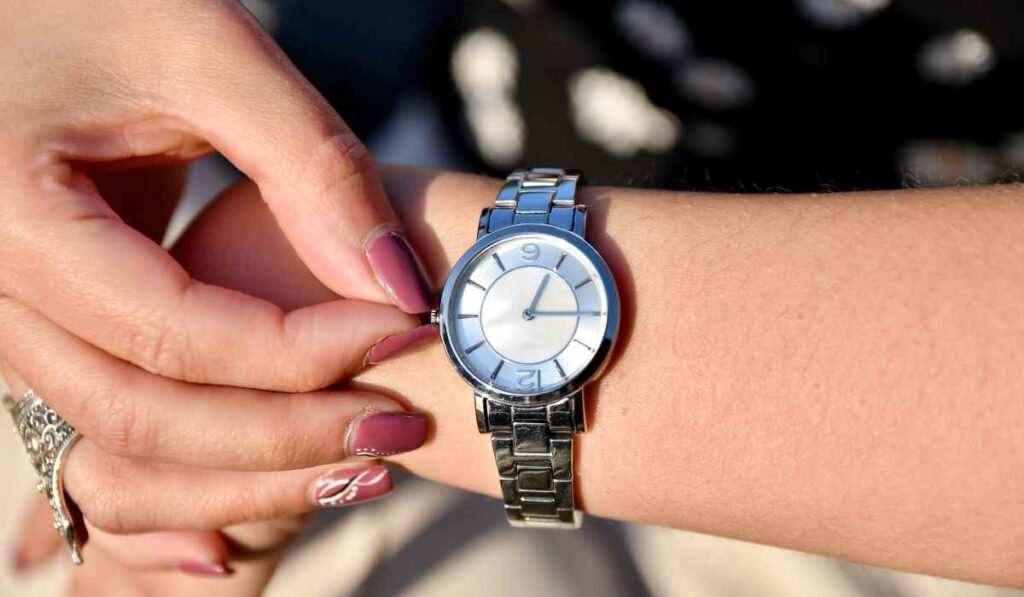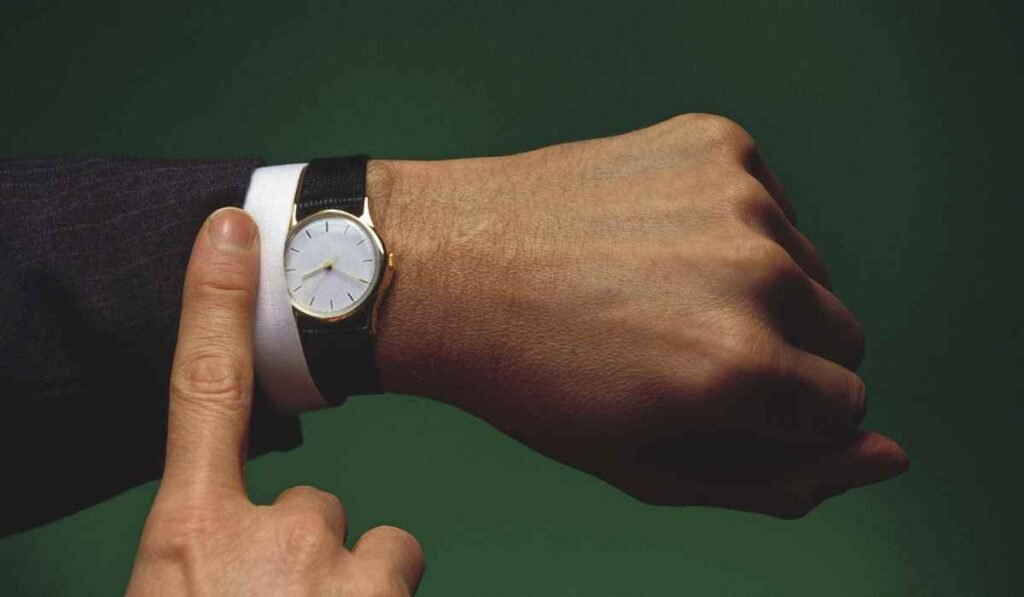Wearing a watch is not just about telling time; it’s a style statement. But have you ever wondered how tight your watch should be for the perfect balance between comfort and aesthetics? In this guide, we’ll walk you through the steps to achieve the ideal watch tightness.
Table of Contents
ToggleHow tight is too tight?
A watch should be snug but not too tight on your wrist, like a comfortable hug for your wrist. You should be able to slide one finger under the band without it feeling too loose or too tight.

Why the Perfect Fit Matters
Before we dive into the nitty-gritty of watch fit, let’s understand why it’s crucial. The ideal watch fit offers several advantages:
1. Comfort
A watch that’s too tight can dig into your skin, causing discomfort and even pain. Conversely, a loose watch may slide around, making it equally uncomfortable. Finding the perfect fit ensures you can wear your watch all day without issues.
2. Style
Wearing a well-fitted watch elevates your style. It accentuates your wrist, adding a touch of sophistication to your overall appearance.
3. Functionality
An ill-fitting watch can impact its functionality. A loose watch might not stay in place, affecting timekeeping accuracy, while a tight one can hinder your wrist’s movement.
Finding Your Base Measurement
Before you start adjusting your watch, you need to find your base measurement. Measure your wrist’s circumference with a flexible measuring tape. This measurement will be the foundation for choosing the right watch size. Here are two ways you can find your perfect fit.
1. The Finger Rule
One commonly used method to determine the right watch fit is the “finger rule.” To use this rule, follow these simple steps:
- Place your watch on your wrist.
- Insert one finger (index or middle finger) between your wrist and the watchband.
- If you can comfortably fit one finger, your watch is likely the right fit.
The finger rule ensures that your watch is snug but not overly tight. However, this is just a guideline, and individual preferences may vary.
2. The Snugness Test
Another method to assess your watch’s fit is the snugness test. Here’s how it works:
- Wear your watch as you normally would.
- Pay attention to how it feels. Does it pinch or constrict your wrist? Is it sliding around?
Based on your observations, adjust the fit accordingly. The goal is to find the sweet spot where your watch feels secure but not too tight.

Consider the Watch Type
The ideal watch fit can also depend on the type of watch you’re wearing:
1. Metal Bracelet Watches
For metal bracelet watches, a snug fit is recommended. The bracelet should conform to your wrist without pinching.
2. Leather Strap Watches
Leather strap watches tend to be more comfortable when slightly looser. However, they shouldn’t be so loose that they dangle.
3. Rubber or Nylon Strap Watches
Watches with rubber or nylon straps are versatile. You can adjust them to your preferred fit, but avoid making them overly tight.
Watch Sizing for Women
Delicate and Feminine: Women’s watches come in various styles, from delicate and feminine to bold and statement pieces. A more delicate watch might be worn slightly looser for comfort, while bold watches can be worn snugly for a striking effect.
Bold and Statement: If you have a bold and eye-catching watch, wearing it tighter can draw more attention to your wrist and make a powerful statement.
Watch Size Chart for Women in Cm & Inches
Here’s a table that provides watch fit recommendations for women based on wrist measurements.
| Wrist Measurement (cm) | Wrist Measurement (inches) | Watch Fit Recommendation for Women |
|---|---|---|
| Less than 13 cm | Less than 5.1 inches | Too small |
| 13 – 15 cm | 5.1 – 5.9 inches | Snug but comfortable |
| 15 – 17 cm | 5.9 – 6.7 inches | Ideal fit |
| 17 cm or more | 6.7 inches or more | Too loose |
Watch Sizing for Men
Classic and Subtle: Men’s watches often have a classic and subtle design. A comfortable but secure fit is essential, ensuring the watch stays in place without feeling restrictive.
Bold and Masculine: For bold and masculine watches, a tighter fit complements the robust design. It emphasizes the timepiece’s presence on your wrist.
Watch Size Chart for Men in Cm & Inches
Here’s a table that provides watch fit recommendations for men based on wrist measurements.
| Wrist Measurement (cm) | Wrist Measurement (inches) | Watch Fit Recommendation for Men |
|---|---|---|
| Less than 15 cm | Less than 5.9 inches | Too small |
| 15 – 17 cm | 5.9 – 6.7 inches | Snug but comfortable |
| 17 – 19 cm | 6.7 – 7.5 inches | Ideal fit |
| 19 cm or more | 7.5 inches or more | Too loose |

Analog vs. Digital Watches
Sizing Analog Watches: Analog watches usually have a traditional round face and are versatile in terms of sizing. The same principles of the two fingers rule apply, allowing for comfort and style.
Sizing Digital Watches: Digital watches may have different shapes, so finding the right fit may vary. Pay attention to the watch’s design and ensure it doesn’t feel too tight or too loose when worn.
Watch Fit for Different Occasions
The ideal watch fit can also vary depending on the occasion:
1. Casual Wear
For everyday wear, a comfortable fit is key. Your watch should feel snug but not restrictive.
2. Formal Events
During formal events, a slightly tighter fit is often preferred, as it adds a touch of elegance to your attire.
3. Sports and Activities
For sports and physical activities, a snug fit is crucial to prevent the watch from bouncing around or slipping during movement.
Taking Care of Your Watch
Your watch is more than an accessory; it’s a long-term investment. To keep it in top shape, you need to perform regular maintenance.
Cleaning and Maintenance
Clean your watch regularly with a soft, damp cloth to remove dirt and sweat. If your watch is water-resistant, you can rinse it with clean water and dry it thoroughly.
Replacement Parts
If you notice wear and tear on the band or watch face, consider replacing parts to maintain the watch’s functionality and appearance.

Here are some of the commonly asked questions:
What’s the ideal tightness for a watch?
The ideal tightness for a watch is when you can comfortably fit two fingers between the watch and your wrist. This ensures both comfort and style.
Can a too-tight watch affect my health?
Wearing a watch that is too tight can restrict blood flow and cause discomfort. It’s essential to find the right balance for both style and health.
How do I measure my wrist for watch sizing?
Measure your wrist’s circumference with a flexible measuring tape to determine your base measurement for choosing the right watch size. Follow the size table added above to measure your sizing.
Should the watch leave an imprint on my skin?
No, your watch should not leave an imprint on your skin. If it does, it’s too tight and needs adjustment.
Can I adjust the watch size at home?
You can adjust some watch bands at home, especially snap-on bands. However, for more complex adjustments, it’s recommended to seek professional help to avoid damaging your watch.
Conclusion
The perfect watch fit is a balance between comfort, style, and functionality. While the finger rule and snugness test provide helpful guidelines, personal preference and the type of watch you wear play significant roles.
Remember to consider the weather and the occasion to ensure the best fit for your watch. So, when someone asks, “How tight should a watch be?”—you’ll have the knowledge to guide them to the perfect fit that suits their needs and style.
